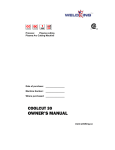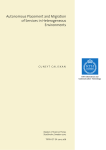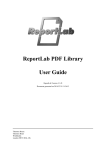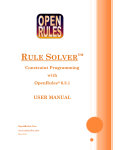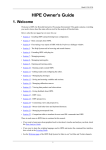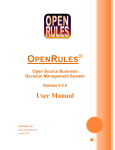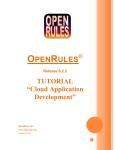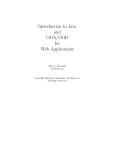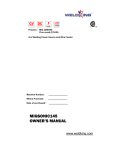Download ORD User Manual
Transcript
O R D
PEN
ULES
IALOG
Developing Web-based Questionnaires with OpenRules
User Manual
ORD is a software product that allows business analysts to develop and
maintain web-based dialogs (questionnaires) with complex interaction logic.
This tutorial describes main product concepts and components and provides
concrete examples of web-based dialogs.
OpenRules, Inc.
January-2012
Copyright © 2009-2012, OpenRules, Inc.
Table of Contents
Main Concepts ................................................................................................................................ 3
Dialog .......................................................................................................................................... 3
Pages ........................................................................................................................................... 4
Sections ....................................................................................................................................... 5
Questions..................................................................................................................................... 5
Question Types ........................................................................................................................ 6
Input Validation ...................................................................................................................... 9
Question Properties .............................................................................................................. 10
Answers to Multi-choice Questions ......................................................................................... 11
Default and Possible Answers .............................................................................................. 11
Defining Combo-boxes through Arrays ............................................................................... 12
Automatically Calculated Responses ...................................................................................... 13
Navigation Rules ...................................................................................................................... 14
Update Rules ............................................................................................................................ 14
Hide/Show Pages, Sections, Questions ................................................................................ 15
Linking Combo-Boxes ........................................................................................................... 15
Custom Questions and Actions ................................................................................................ 17
Generating PDF Documents .................................................................................................... 18
Authorized Access to Questionnaires ...................................................................................... 18
Saving and Restoring Dialog States ........................................................................................ 21
Dialog Templates ......................................................................................................................... 23
DialogType0 - simple dialog with two navigation buttons .................................................... 23
1
Copyright © 2009-2012, OpenRules, Inc.
DialogType1 – adds Login/Logout and Save/Load facilities .................................................. 23
DialogType2 – adds a menu ..................................................................................................... 24
DialogType3 – new question on top of the page ..................................................................... 24
Creating Your Own Questionnaire ............................................................................................. 26
Technical Information .................................................................................................................. 27
Installation and Configuration ................................................................................................ 27
Supporting Rule Templates and Forms .................................................................................. 29
Customization and Integration – Developer Notes ................................................................ 29
2
Copyright © 2009-2012, OpenRules, Inc.
OPENRULES DIALOG
How to Build Web-based Questionnaires
OpenRules Dialog (ORD) is a software product built on top of the open source Business Rules
Management System “OpenRules”. It allows non-technical people to develop and maintain
web-based questionnaires (dialogs) using only Excel and without any necessity to learn
different web programming techniques. A questionnaire is a web application that can be
described in terms of pages, sections, and different types of questions. Layouts of pages,
sections, questions, and complex relationships between them can be expressed in a very
natural way using simple and intuitive Excel tables. This document describes the main
concepts and provides concrete instructions that help you to install and use the product. It
also includes specific examples of different web-based questionnaires.
MAIN CONCEPTS
OpenRules Dialog (ORD) uses the following concepts to represent different business
questionnaires as web applications. Instead of forcing a questionnaire designer to learn
different web development techniques, ORD introduces the following basic concepts:
-
Dialog
-
Pages
-
Sections
-
Questions
-
Answers (default and possible)
-
Automatically calculated responses
-
Navigation rules
-
Page content update rules.
All these concepts could be presented in one (or several) Excel files in simple tables with
predefined structures. Along with a predefined rich set of question types, a user can easily
extend the ORD functionality by adding custom question types and dialog actions.
Dialog
When a user starts a web session to fill out a questionnaire there is always one instance of
the object “dialog” that represents the current state of the interaction with a user. The Dialog
3
Copyright © 2009-2012, OpenRules, Inc.
object always knows what page a user is currently accessing and what last action has been
executed by a user (e.g. clicked on the ”Next” button, selected “Yes” for a certain Yes/No
questions, click on a certain hyperlink, etc). This information is used by the navigation and
update rules defined in the ORD to refresh page content based on the latest answers or to
hide/show some sections, questions, calculated automatic responses, etc. As a questionnaire
developer you do not deal with the object “dialog” directly but it is effectively used by the
ORD templates that specify the interaction logic.
Pages
ORD considers any questionnaire as a sequence of web pages through which a user can
navigate using actions “Next” and “Prev” (usually presented as push-buttons) or any other
application specific mechanism such as a menu. Here is an example of the Excel table
“pages”:
Rules pages extends pagesTemplate
#
Page ID
Page Name
Hidden
1.1
1.2
Page 1
Page Title 1
Section
Column 1
Section
Column 2
section11
section12
section13
1.3
section14
2.1
section21
2.2
Page 2
Page Title 2
section22
2.3
3.1
3.2
4
Section
Column 3
section23
Page 3
Page Title 3
Page 4
Page Title 4
Yes
section31
section32
section4
As you may guess, this questionnaire consists of 4 pages. Page 1 consists of 4 sections, and
section12 is allocated on the right of section11, while section13 goes under the section11,
section14 goes under section13, etc. Each page may have (or may not have) a title that will be
shown on the top of the page. You may use any string as a page ID as long as all page IDs
are unique. The order of pages in this table reflects the natural navigation order through
them assuming that every page has navigation buttons “Next” and “Prev”. When the order of
pages depends on the entered answers or other factors, these special cases can be described
in special navigation rules (see below).
Note. The very first column is usually used for decorative purposes only: it may contain a
page order number that has no particular meaning or it may be left empty. However, you
cannot remove this column or merge cells inside it.
4
Copyright © 2009-2012, OpenRules, Inc.
Sections
The previous table “pages” defines a relative layout for sections inside every page. The
sections themselves are defined in the Excel table “sections” and may look as follows:
Rules sections extends questionsTemplate
#
1-3
4
Section
ID
Section
Name
section11
Section Title
11
section12
Section Title
12
Hidden
Question
Column 2
Question
Column 3
question1
question2
question3
question4
5
6
Question
Column 1
question5
7
Yes
question6
question7
…
As you can guess, this table defines all sections and their content (questions). For example,
the section11 consists of 4 questions. Question2 will be placed on the right of the question1,
question3 – on the right of the question2, and question4 goes under the question1. Each
section may have (or have not) a title that will be shown on the top of the section. You may
use any string as a section ID as long as all section IDs are unique. The column “#” is similar
to the one for pages and can contain any information or be empty.
Questions
The previous table “sections” defines a relative layout for questions inside every section.
The questions themselves are defined in the Excel table “questions” and may look like the
following one:
Rules questions extends questionsTemplate
Question
Question
Question
Id
Name
Type
question1
First name:
TextBox
question2
Middle initial:
TextBox
question3
Last name:
TextBox
Spouse's
question4
social security
TextBox
number:
Can somebody
claim your
question5
RadioButton
spouse on
their return?
Size
Hidden
Validation
18
2
20
SSN
5
Copyright © 2009-2012, OpenRules, Inc.
wage
Wage
TextBox
Range 1000
100000000
…
You may use any string as a question ID as long as all question IDs are unique. There are no
limits for question names, but you should keep in mind that long names could affect
automatically adjusted question/section layouts.
The column “Size” allows you to change the size (number of displayed characters) in a
TextBox’s input field. The default size is 20. The validation criteria are described below.
There are no limits to the number of questions and usually all questions for all sections are
defined in the table with the name “questions”. If there are too many questions you may
split them in separate tables that look like this one but have different names, for example
“questions1” and “questions2”. Then you have to add another table with the name
“questions” that will invoke these two tables:
Method void questions(Section section, String questionId)
questions1(section, questionId);
questions2(section, questionId);
Question Types
The current version of OpenRules Dialog supports the following question types:
Question Type
Comment
TextBox
A regular question with a
label (name) and an input
field of a certain size
Password
ReadOnly
Example
Similar to TextBox but the
entered text would be
display as stars
Similar to the TextBox but
the input field is
automatically calculated
and cannot be changed
(indicated by a slightly
different background –
Azure)
6
Copyright © 2009-2012, OpenRules, Inc.
Question Type
Comment
TextArea
Similar to the TextBox but
the input field may consist
of several lines
ComboBox
Label with input that
allows selection from
possible answers
ComboBox
Submit
The same as a regular
ComboBox but refreshes
the page upon a selection
ComboBox
Domain
Similar to ComboBox but
allows you to define
different display and actual
choices
CheckButton
Allows the selection of one
or more multiple
alternatives. Each
alternative should be
defined by a separate check
button. The question’s
name is used as the check
button text. The question’s
ID is used as a part of the
name of the proper action,
e.g. Check-Aviation or
Uncheck-Aviation
RadioButton
Allows the selection of one
choice from among
multiple alternatives
Example
Selection of “Yes” may show a hidden information
for an additional card
You may specify the question’s domain as
“1,Yes;0,No”. Then the combo-box will look like
above but when a user selects “Yes” the actual
answer is “1”. When a user selects “No” the actual
answer is “0”.
7
Copyright © 2009-2012, OpenRules, Inc.
Question Type
Comment
RadioButton
Vertical
The same as a regular
RadioButton but places the
choices vertically
RadioButton
Submit
RadioButton
VerticalSubmit
RadioButton
VerticalDomain
ActionButton
ActionImage
Example
Allows the selection of one
choice from among
multiple alternatives and
submits this choice to the
server to refresh other
pages, e.g. to hide/show
related questions
The same as a regular
RadioButtonSubmit but
places the choices
vertically
Similar to
RadioButtonVertical but
allows you to define
different display and actual
choices
You may specify the question’s domain as
“1,Yes;0,No”. Then the buttons will look like above
but when a user selects “Yes” the actual answer is
“1”. When a user selects “No” the actual answer is
“0”.
Creates a push-button
whose name could be
associated with some
action defined in
navigation rules.
If no action is defined, pushing (selecting) the
button will force the page to be refreshed with a
possible recalculation of all auto-responses
Creates a push-button with
a custom image whose path
is defined by the question’s
name. The question ID is
used to define the last user
action that could be used in
the navigation rules.
An image that represents a delete button
8
Copyright © 2009-2012, OpenRules, Inc.
Question Type
Comment
ActionHyperlink
Creates a hyperlink whose
text corresponds to the
question’s name. The
question ID is used to
define the last user action
that could be used in the
navigation rules.
Message
Empty
Example
Can be used to represents different menus
Displays a text defined as
the question name
Creates an empty question
that can be used as a cell
filler
Custom
This question can be
defined by a customer
using the rules table
“customQuestions”
This custom hyperlink generates and displays a
PDF document base on the answered questions
Input Validation
You may associate a validation criterion with any TextBox – see for example “SSN” and
“Range 1000 100000000” in the above table “questions”. ORD will compare the entered
answer with the question’s validation criterion, and if it is violated, ORD will place an error
message (in red) right below the invalid answer. Here is the list of currently supported
validation criteria:
Validation
Criterion
RANGE <from> <to>
Comment
Example of the Error
Message
Validates that the answer to the
question is an integer or real number
that should be within the interval
[from;to]
ERROR: The answer should
be within 1 and 100
9
Copyright © 2009-2012, OpenRules, Inc.
Validates that the answer is a valid
date for the current locale, e.g.
20/5/2009 is invalid for the US locale
ERROR: invalid date format
for the current locale
EMAIL
Validates that the answer is a valid
email address
ERROR: invalid email
address
URL
Validates that the answer is a valid
URL address
ERROR: invalid URL
address
SSN
Validates that the answer has a
valid Social Security Number format
ERROR: SSN should have a
format 999-99-9999
CREDITCARD
Validates that the answer has a
valid CREDIT Card Format
ERROR: invalid credit card
number
DATE
Validates if the answer matches the
regular expression defined by
regular expression “pattern”, e.g.
SSN corresponds to the regular
expression "[0-9]{3}-[0-9]{2}-[0-9]{4}"
REGEX <pattern>
ERROR: <answer> doesn’t
match the pattern <pattern>
USERID
Validates if the answer is a valid
user ID by calling a custom method
“validateUserID”
ERROR: invalid user ID
PASSWORD
Validates if the answer is a valid
password by calling a custom method
“validatePassword”
ERROR: invalid password
More validation criteria could be added without programming (see the file DialogForms.xls).
Another way to validate user input is to add special conditions directly in the table
“navigateRules” – see an example in the Dialog1040EZ project.
Question Properties
You may associate with each question certain properties by adding additional columns to the
table “questions”. For example, in the sample project DialogType3 we added properties
“Country”, “Category”, and “Comments” to the table “questions”:
10
Copyright © 2009-2012, OpenRules, Inc.
Now we may display only questions that correspond to certain countries and categories and
produce additional comments when we receive answers to certain questions. See the project
DialogType3 for more details.
Answers to Multi-choice Questions
You may define possible answers for multi-choice questions using combo-boxes.
Default and Possible Answers
You may define the default and possible answers for some or all questions using an Excel
table similar to this one:
Data Answers answers
Question Id
YourFirstName
YourMiddleInitial
YourLastName
AddressLine1
AddressLine2
City
State
ZipCode
YourSSN
MarriedFillingJointly
Default Answer
John
N.
Smith
25 Maple Street
Apt. 3C
Edison
NJ
08840
164-86-2298
No
Possible Answers
USstates
yesno
Here the possible answers “USstates” and “yesno” refer to the custom Excel Data table
“possibleAnswers”:
Data PossibleAnswers possibleAnswers
choices
id
ID
employmentTypes
gender
Answers
Employed
Unemployed
Full Time Student
Retired
Male
Female
11
Copyright © 2009-2012, OpenRules, Inc.
Yes
No
AL
AK
AR
…
yesno
USstates
Defining Combo-boxes through Arrays
There is another way to define possible answers for combo-boxes. Possible answers may be
defined in Data array using predefined Data types such as ArrayString – see
http://openrules.com/docs/man_data.html#Predefined Datatypes:
Data ArrayString LOBs
value
LOB
HMO
EPO
PPO
You may have many arrays like this one and they can be used as possible answers for some
combo-boxes in the following way:
Rules questions extends questionsTemplate
C1
A1
Question
Question Id Question Name
Type
A3
Size
Hid
den
Valida
tion
Answers
Q1_LOB
LOB
ComboBox
:=getArray("LOBs")
Q1_InOut
In or Out
Network
ComboBox
:=getArray("InOutNetworks")
Q1_Location
Service Location
ComboBox
:=getArray("ServiceLocations")
Q1_Service
Service
ComboBox
:=getArray("Services")
Here the table “questions” uses an optional column “A3” from the template
“questionsTemplate”. It requires that the cells in this column have the standard OpenRules
type ArrayOfStrings. You may convert arrays like LOBs to the type ArrayOfStrings using
the method “getArrayOfStrings” defined in the Dialog.xls. Then for efficiency reason (and for
better expressiveness) you may add them one table with unique names:
12
Copyright © 2009-2012, OpenRules, Inc.
Rules void createArraysOfAnswers()
A1
dialog().put(id,array);
String id
ArrayOfStrings array
ID
Array of Strings
LOBs
:=getArrayOfStrings(LOBs)
InOutNetworks
:=getArrayOfStrings(inOutNetworks)
:=getArrayOfStrings(serviceLocations)
ServiceLocations
:=getArrayOfStrings(services)
Services
The method:
Method ArrayOfStrings getArray(String id)
return (ArrayOfStrings) dialog().get(id);
is used within above table “questions” to define possible answers for combo-boxes.
Automatically Calculated Responses
Answers to some questions could be automatically calculated based on the answers to other
questions and possible other information (for example, data coming from a database). The
rules for such auto-responses should be placed in the table “autoResponses” that may look
like this one:
Rules autoResponses extends autoResponsesTemplate
Question Id
Auto Response
{
double wages = d.getDoubleAnswer("Wages");
double taxableInterest = d.getDoubleAnswer("TaxableInterest");
double unemploymentCompensation =
AdjustedGrossIncome d.getDoubleAnswer("UnemploymentCompensation");
double answer = wages + taxableInterest +
unemploymentCompensation;
format(answer);
}
{
double wages = d.getDoubleAnswer("Wages");
format(wages + 250);
A
}
B
:= format(750)
{
double a = d.getDoubleAnswer("A"); out("A="+a);
double b = d.getDoubleAnswer("B"); out("B="+b);
format(Math.max(a,b));
C
}
13
Copyright © 2009-2012, OpenRules, Inc.
{
double answer = 4750;
Question marriedFillingJointly = d.getQuestion("MarriedFillingJointly");
if (marriedFillingJointly.isAnswerTrue())
answer = 9500;
format(answer);
D
}
Navigation Rules
ORD provides a built-in support for navigation between pages. The order of pages in the
table “pages” reflects the natural navigation order assuming that every page has navigation
buttons “Next” and “Prev”. When the order of pages depends on the entered answers or other
factors, these special cases can be described in special navigation rules table
“navigationRules” that may look like the tables below:
Rules navigationRules extends navigationTemplate
C1
C2
C3
A1
IF
Current Page is
AND
Action
is
AND
Answer to
Question
Is or
IsNot
Value
TaxpayerGeneral
Information
Next
MarriedFillingJointly
IsNot
Yes
IncomeData
IncomeData
Prev
MarriedFillingJointly
IsNot
Yes
TaxpayerGeneral
Information
THEN
Go to Page
You may create different navigation rules selection different conditions and actions from the
template “navigateDialogTemplate” described in the configuration file DialogRules.xls.
Update Rules
ORD allows a questionnaire designer to define special conditions and execute the proper
actions when the content of certain pages is updated by a user. For example, the update rules
define conditions when some pages, sections or questions should be hidden or shown. The
updating logic can be defined in the decision table “updateRules” that may look like this
one:
14
Copyright © 2009-2012, OpenRules, Inc.
This decision table is created based on a template “updateDialogTemplate” defined in the
standard file “DialogRules.xls”.
Hide/Show Pages, Sections, Questions
The updating rules allow you to effectively implement hide/show features on any level: page,
section, or question. The standard Dialog object supports the following methods:
hidePage(String pageID)
showPage(String pageID)
hideSection(String sectionID)
showSection(String sectionID)
hideQuestion(String questionID)
showQuestion(String questionID)
You may invoke these methods as a code in the column “Execute Code” or use more
convenient columns “Hide/Show Page”, “Hide/Show Section”, and “Hide/Show Question”.
Naturally, when you invoke the method “hidePage” it hides all sections in this page. When
you invoke the method “hideSection” it hides all questions inside this section. Conversely,
when you call “showSection” it shows all questions from this section unless some of them
were specifically hidden earlier.
You may also use this table to respond to a question X with an answer Y, set the dialog
status, and much more – see the template “updateDialogTemplate” in the file
dialogRules.xls.
Note. For efficiency reasons the hidden pages, sections or questions are not analyzed during
the page “refresh” that occurs during a user session whenever ORD delivers a new page or
updates the current one.
Linking Combo-Boxes
The updating rules allow you to link several combo-boxes in such a way that when a user
makes a selection in one combo-box the choices in other combo-boxes may be modified. For
examples, let’s define two questions Q35 “Car Make” (BMW, Lexus, Acura, …) and Q36 “Car
Model” (5 Series, X3, X5, GS 350, RL, TL, …). Each question is a combo-box but when a user
15
Copyright © 2009-2012, OpenRules, Inc.
selects “BMW” for the first question we want to display only BMW’s models as possible
choice for the second question.
Here is one possible way to do it. First, we will add different car makes to the list of possible
questions used to define Q35:
Data PossibleAnswers possibleAnswers
ID
Answers
Employed
Unemployed
employmentTypes
Full Time Student
Retired
Male
gender
Female
Yes
yesno
No
Select
BMW
Car-Makes
Lexus
Acura
Data Answers answers
Question Id
Default Answer
Possible Answers
Q21
Q31
11371
MA
USstates
Q32
Employed
employmentTypes
Q33
Q35
Female
gender
Car-Makes
Both questions Q35 and Q36 will belong to Page3 and are defined as a ComboBox. However,
to make sure that Page3 will be updated every time a user makes a selection inside the Q35
combo-box, this question should be defined as “ComboBoxSubmit”!
To define the dynamic content of the question Q36 “Car Model”, we will define 3 arrays of
possible models for BMW, Lexus, and Acura:
Method String[]
getBMWModels()
Method String[]
getLexusModels()
Method String[]
getAcuraModels()
return ArrayString.getValues
(BMWModels);
return ArrayString.getValues
(LexusModels);
return ArrayString.getValues
(AcuraModels);
Data ArrayString
BMWModels
Models
Select
1 Series
3 Series
5 Series
X3
X5
Data ArrayString
LexusModels
Models
Select
ES 350
GS 350
GS 450
GS 450h
LS 460
Data ArrayString
AcuraModels
Models
Select
MDX
RDX
RL
TL
TSX
ZDX
To link these arrays to question Q36 to generate different answers for question Q35, we
expand table “UpdateRules” as follows:
16
Copyright © 2009-2012, OpenRules, Inc.
We added one more action “A7” predefined in the DialogRules.xls. We use it in the last three
rules that say exactly what we need, e.g.:
IF Answer to Question Q35 is <BMW>
THEN Limit Answers to Question Q36 to Array <getBMWModels>
See the sample project DialogType0 for the actual implementation. Similarly we can connect
more combo-boxes. More sophisticated ways to define complex inter-question relationships
are under development and will be provided in the next ORD releases.
Custom Questions and Actions
Along with predefined question and action types you may create your own questions/actions
using type “Custom”. To do this you have to define the proper layout in the table
“customQuestions” similar to the following Excel tables:
Rules customQuestions extends customQuestionTemplate
Question Id
Custom Question Layout
GeneratePDF
:= layoutGeneratePDF()
Layout TableLayout layoutGeneratePDF()
<a href="{makePDFHref()}" target="_blank">
Click here to Preview and/or Print Your Tax Return using Adobe Acrobat
</a>
17
Copyright © 2009-2012, OpenRules, Inc.
This layout invokes a separately described Excel table “makePDFHref” that actually maps
the answered questions to the proper PDF form. Your layout may execute your own methods
such as any java method.
Generating PDF Documents
OpenRules Dialog includes a special module "pdfgen" that allows you to generate PDF
documents based on your filled out questionnaire. You may look at the sample project
“Dialog1040EZ” that explains how to generate a pdf document. This example is based on the
well-known US tax form 1040EZ. The application takes the standard 1040EZ pdf form
publicly available from the IRS web site and fills it in after an interactive session with a
taxpayer. The detailed tutorial Dialog100EZ can be found here.
The pdfgen module uses 3rd party PDF generation software developed by Big Faceless
Organization (BFO) - see http://big.faceless.org. An evaluation version of the BFO software
is included. However, for production implementations you will need a commercial copy of the
BFO software that could be purchased directly from BFO or from OpenRules.
Authorized Access to Questionnaires
Usually an authorized access is provided through Login/Logout functionality. Here is an
example of a Login screen:
This screen can be easily implemented as the very first page of your questionnaire with one
section “Login”:
18
Copyright © 2009-2012, OpenRules, Inc.
The proper questions may be defined in the table “questions” as follows:
There are two special validation criteria USERID and PASSWORD that are associated with
two custom (user-defined) validation methods. These methods should be specified in a
separate rules table “customValidate” in the file Main.xls:
Rules customValidate extends validateAnswerTemplate
IF
Validation Pattern
AND
Answer Defined
PASSWORD
THEN
Validation Result
:= validatePassword(q)
USERID
:= validateUserID(q)
Here we defined two validation methods:
-
validateUserID
-
validatePassword.
These methods have a predefined signature but the actual implementation depends on the
way you want to keep you user identification information. For example, in the template
DialogType2 we use the following implementation placed in the file Main.xls. First, we define
the datatype DialogUser:
Datatype DialogUser
String
String
id
password
Then we create the table “users” that contains different pairs “UserID” and “Password”:
Data DialogUser users
id
User ID
Robinson
Smith
Green
password
Password
1234
4567
1111
19
Copyright © 2009-2012, OpenRules, Inc.
Our validation methods should try to find the answers to the questions “ID” and “Password”
in the array “users”. To find out if a user with a certain ID is located in the array “users” we
created a simple method:
Method DialogUser findDialogUser(String id)
for(int i=0; i<users.length; i++) {
if (users[i].id.equals(id))
return users[i];
}
return null;
Now we can implement the method “validateUserID” as follows:
Method String validateUserID(Question questionID)
String msg ="";
if (dialog().isAction(“Init”))
return msg;
DialogUser user = findDialogUser(questionID.answer);
if (user == null) {
dialog().addError();
msg = "ERROR: Invalid User ID";
}
return msg;
If there are no users whose ID corresponds to an answer to the question “ID”, this method
will add the proper error to the Dialog and this error will be displayed during Login.
Similarly one can define the method “validatePassword”:
Method String validatePassword(Question questionPassword)
String msg ="";
if (dialog().isAction(“Init”))
return msg;
String id = dialog().getAnswer("ID");
DialogUser user = findDialogUser(id);
if (user == null || !user.password.equals(questionPassword.answer)) {
dialog().addError();
msg = "ERROR: Invalid password";
}
return msg;
The actual business logic that validates the entered ID and Password depends on your
specific implementation which can be realixed in two methods similar to the described ones.
For example, you may associate the list of users and their password with a table in your
20
Copyright © 2009-2012, OpenRules, Inc.
database using simple Excel import facilities. Or you may use Java methods that “talk” to a
database through a JDBC interface.
In all cases if an answer to the question “ID” or “Password” is invalid, the appropriate
message will be displayed and a user will remain on the “InitialPage” with the Login button.
When the answers are valid, a user will see the next page “Page1” as defined in the table
“navigateRules”.
Note. The question “Restore previous dialog session?” allows a user to start filling in the
questionnaire from scratch (“No”) or to restore previously entered answers (“Yes”).
Saving and Restoring Dialog States
While your web interface will guide a user through a set of pages and questions, the user
does not have to answer all the questions during one session. The user may stop at any point
and all entered information may be saved. The user may start a new session after s/he
obtains more data and is ready to enter it.
In the Login screen on the picture above we used the question “Restore previous dialog
session?”. If a user selects “Yes” as an answer to this question, the last saved state of this
questionnaire (if any) will be restored and all already answered questions will have
previously defined answers. Otherwise, a user will start filling in the questionnaire from
scratch. How might this functionality be implemented?
In the template project DialogType2 we defined a reaction to the answer “Yes” for this
question in the table “navigateRules” as a special action:
:= loadDialog( d.getAnswer("ID"))
The method ‘loadDialog” (as well as its counterpart “storeDialog”) is defined in the file
Main.xls in the following way:
Method String loadDialog(String id)
String filename = "./work/" + id + ".answers";
if (dialog().load(filename) == null) {
dialog().setStatus("ERROR: Unable to load dialog from " + filename);
dialog().addError();
}
else
dialog().setStatus("Dialog has been reloaded from " + filename);
return filename;
It loads answers to all questions as they were stored in the file “Robinson.answers” where
“Robinson” is the entered user’s ID. This file is located in the subdirectory “work” of the
“basedir” directory of the web server, on which the web application was deployed. In
particular, it can be found in the Tomcat’s “webapps/work” subdirectory.
21
Copyright © 2009-2012, OpenRules, Inc.
To store the current state of the questionnaire, a user may select an action such as “Save”
that is defined as a hyperlink “Save” in the template project DialogType2:
A reaction to the action “Save” is defined in the table “navigateRules” as a special action:
:= storeDialog( d.getAnswer("ID"))
The method ‘storeDialog” is defined in the file Main.xls as the following:
Method String storeDialog(String id)
String filename = "./work/" + id + ".answers";
if (dialog().store(filename) == null) {
dialog().setStatus("ERROR: Unable to store dialog at " + filename);
dialog().addError();
}
else
dialog().setStatus("Dialog has been stored at " + filename);
return filename;
A user may use different names for the methods or completely change the way a dialog is
being stored and loaded. The standard class Dialog provides the following convenience
methods that give a user some flexibility:
store(String fileName)
load(String fileName)
storeToXML(OutputStream outStream)
loadFromXML(InputStream outStream)
store(OutputStream outStream)
load(InputStream outStream)
In particular, storing the questionnaire answers in an XML file may simplify its interaction
with other applications.
22
Copyright © 2009-2012, OpenRules, Inc.
DIALOG TEMPLATES
ORD comes with a set of dialog templates that allow a user to build different types of
questionnaires. These templates have been created by OpenRules or contributed by
customers. Below we describe the currently available templates with their sample views.
DialogType0 - simple dialog with two navigation buttons
This template includes all types of questions and two buttons “Next” and “Prev” that allow
you to navigate throw pages. Here is a typical view:
DialogType1 – adds Login/Logout and Save/Load facilities
DialogType1 demonstrates how to implement an authorized access with Login/Logout
functionality. A user may Save the current state of the interaction and later Restore this
state (during Login) with the saved answers. Here is a typical view:
23
Copyright © 2009-2012, OpenRules, Inc.
DialogType2 – adds a menu
In addition to the DialogType1 features, the DialogType2 demonstrates how to create a menu
as in the following view:
DialogType3 – new question on top of the page
This is a different type of dialog (the layout was proposed by Ronnie Barkan from
www.regpointer.com). While supporting the same capabilities as the DialogType2 template,
this dialog allows a user:
o
To enter one question at a time. This new question is always shown on the top of the
current page
o
To show already answered questions at the bottom of the page starting with the last
answered question.
Additionally, DialogType3 demonstrates how:
-
To assign properties (such as “Country”) to different questions and to ask only
questions with certain properties
-
To generate a results page that displays all answered questions (and possibly gives
additional information associated with those questions properties.)
Here are typical views:
24
Copyright © 2009-2012, OpenRules, Inc.
25
Copyright © 2009-2012, OpenRules, Inc.
CREATING YOUR OWN QUESTIONNAIRE
To create your own questionnaire using the Eclipse IDE, follow these steps:
1) Copy and paste any template-project DialogType<X> under your own name, say
“DialogMy”
2) In the file “build.properties” replace deploy.name= DialogType<X> to
deploy.name=DialogMy
3) In the file “run.html” replace DialogType<X> with DialogMy in the proper URL
address. Also, you may adjust the title of your application in this simple htmllauncher. If you acquired a commercial ORD license, enter it as a parameter
license=<your-license-code> instead of license=eval
4) Double-click to deploy.bat to deploy your application on the Tomcat. It should create
the subdirectory “DialogMy” in the webapps directory of your Tomcat.
5) Make sure that Tomcat is up and running. Double-click to DialogMy/run.html and
make sure that your DialogMy works as DialogCreditCard used to work.
6) Your project directory DialogMy/war/rules/ contains two files:
1. Main.xls: describes the structure of your project and its look-and-feel
2. Rules.xls: describes the content and interaction logic of your questionnaire.
7) Start making changes in the file Rules.xls. You should put your own information into
the following tables:
pages – a list of all your pages
sections – a list of all your sections
questions – a list of all your questions
answers – a list of defaults and possible answers. If there are no answers
you still need to keep this table (even when it is empty). This table may use
answer lists defined in the table similar to the one defined in the table
“possibleAnswers” (this is not a key word and standard lists may be
organized differently)
autoResponses (optional) – a list of all your automatically calculated
responses
navigateRules – this decision table defines special conditions when the
default sequential order of pages, sections, or questions is violated and
26
Copyright © 2009-2012, OpenRules, Inc.
different order of pages is required. If you do not have special navigation
rules, you may omit this rules table
updateRules – this decision table defines special conditions for pages
updates such as: a hide/show question, a hide/show section, a response to a
question X with an answer Y, etc. If you do not have special update rules, you
may omit this rules table.
customQuestions (optional) – this table defines application-specific layouts
for custom questions.
8) You may customize the layout of your application by making changes in the file
DialogMy/war/rules/Main.xls. You should put your own information into the
following tables:
1. Environment – this table should always be in place. It describes the default
structure of your rules project. You may modify this table only if you want to
add your own Excel tables or Java classes – read more at
http://www.openrules.com/docs/man_api.html#Integration with Java and
XML
2. mainLayout – this table define the default main layout of your application
with buttons “Next” and “Prev”. You may customize it to your own needs –
see for example the sample projects “DialogCreditCard” and “Dialog1040EZ”.
You may rename the file Main.xls and Rules.xls but in that case please make a
corresponding change to the file “index.jsp”. You may move some tables from this file to
other Excel files – just make sure that you properly modify the Environment table.
TECHNICAL INFORMATION
Installation and Configuration
The current OpenRules Dialog (ORD) distribution is oriented to be used with Eclipse or a
similar IDE, but it can also be used as a stand-alone system with just Excel and Windows
Explorer. ORD is based on the OpenRules BRMS starting with the version 5.3.2.
To install ORD, first make sure that you have OpenRules 5.3.2 (or higher) installed and the
following configuration projects are in place:
-
openrules.config
-
openrules.forms.lib
-
pdfgen (optinal).
27
Copyright © 2009-2012, OpenRules, Inc.
You also should install any Java-based web application server. We will assume that you have
already installed a free Apache Tomcat server – see configuration details at
http://www.openrules.com/docs/man_config.html.
The ORD can be downloaded from http://www.openrules.com/ORD.htm. After downloading
the file “ORD.zip”, unzip it in the same folder where you already have the main OpenRules
configuration project “openrules.config”. You will see a set of ORD projects:
-
DialogType0: a simple dialog with Next/Prev navigation buttons
-
DialogType1: a dialog of the type 0 with a special Login page and an ability to
store/reload the dialog
-
DialogType2: a dialog of the type 1 with a menu instead of Next/Prev buttons
-
DialogType3: a dialog with long pages that always displays the next question to ask
on the top of the page
-
DialogCreditCard: a simple credit card application
-
Dialog1040EZ.: a real application that allows a user to fill in US tax form 1040EZ
and generate a 1040EZ PDF document.
You may import these projects in your Eclipse workspace or in your stand-alone OpenRules
installation directory: just make sure that all these projects are at the same level as
“openrules.config”.
Installation Steps:
Step 1. Deploy openrules.forms.lib at the Tomcat by double-clicking on
“openrules.forms.lib/deploy.bat”.
Step 2. Deploy other sample projects (at least DailogType0) at the Tomcat by double-clicking
on file “deploy.bat”.
Step 3 (optional). If you plan to generate PDF documents, deploy the project “pdfgen” at the
Tomcat by double-clicking on “pdfgen/deploy.bat”.
Step 4. To check that installation was successful, start your Tomcat and double-click on the
file “run.html” for a selected sample project. You should be able to run your ORD-based web
questionnaire.
Any installation or configuration issues? Contact [email protected].
28
Copyright © 2009-2012, OpenRules, Inc.
Supporting Rule Templates and Forms
The basic ORD concepts such as Dialog, Page, Section, Question, and Answer are defined as
Java classes inside the standard OpenRules package “com.openrules.forms.gui.jsp”. Thus,
they are automatically included in the standard OpenRules release (since 5.3.2).
All standard forms (layouts) and rule templates are defined in the Excel files supplied with
the standard OpenRules project “openrules.forms.lib”:
-
Dialog.xls
-
DialogMain.xls
-
DialogForms.xls
-
DialogRules.xls
-
Validators.xls.
Appropriate style sheets are defined in the file openrules.forms.lib/css/lib.css, but can be
overwritten by project specific style sheets such as DialogCreditCard/war/css/project.css.
Customization and Integration – Developer Notes
You may essentially customize your application by changing only layout tables in the file
Main.xls. You also may create your own version of the library “openrules.forms.lib” and
completely change the look&feel of the generated questionnaire (web application).
You may integrate your questionnaire with any 3rd party Java package by adding the proper
import-statements to the Environment table in Main.xls. If you want to use your own Java
object inside your custom rules, you may add these objects to the instance of the class Dialog
that is inherited from the standard Java HashMap. For example, in the file “index.jsp” you
may create your own object “customer” and add it to the dialog as follows:
Dialog.put(“customer”,customer);
Then, inside your Excel rules, you can always gain access to this object by using something
like this:
Customer customer = (Customer) dialog().get(“customer”);
This mechanism gives you complete control over the integration of the Excel-based
questionnaire with your Java application.
29
Copyright © 2009-2012, OpenRules, Inc.
If necessary, ORD allows you to bring the entire power of OpenRules Forms – see
http://openrules.com/docs/man_forms.html. The project DialogType3 provides a good
example of how to do it.
30
































